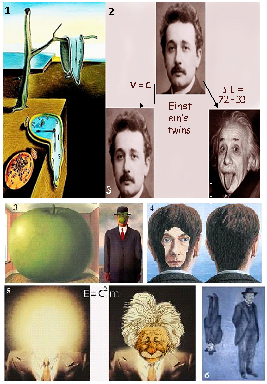Neurosurgery and Neurology Research
OPEN ACCESS | Volume 7 - Issue 1 - 2025
ISSN No: 2836-2829 | Journal DOI: 10.61148/2836-2829/NNR
Abraham Tamir
Ben-Gurion University of the Negev, Beer-Sheba, Israel
Corresponding author: Abraham Tamir, Ben-Gurion University of the Negev, Beer-Sheba, Israel
Corresponding author: Abraham Tamir, Ben-Gurion University of the Negev, Beer-Sheba, Israel
Received date: February 01, 2021
Accepted date: February 05, 2021
published date: February 10, 2021
Citation: Abraham Tamir. “Art and Science Einstein’s Universe via Art”. International Journal of Surgery Case Reports and Images, 1(1); DOI: http;//doi.org/03.2021/1.1003.
Copyright: © 2021 Abraham Tamir. This is an open access article distributed under the Creative Commons Attribution License, which permits unrestricted use, distribution, and reproduction in any medium, provided the original work is properly cited.
The essence of Einstein’s world lies in the concept of relativity. He described it once in the following "way: "When you sit with a nice girl for two hours, it seems like two minutes. When you sit on a hot stove for two minutes, it seems like two hours; that's relativity he said."
The essence of Einstein’s world lies in the concept of relativity. He described it once in the following way: "When you sit with a nice girl for two hours, it seems like two minutes. When you sit on a hot stove for two minutes, it seems like two hours; that's relativity he said." Einstein also boldly stated that there are no absolute quantities, that the magnitude of quantities depends on the relative velocity between an object and the observer, and that every event and measurement is viewed differently depending on the observer's velocity. However, the only measurement that remains constant is the speed of light C in vacuum. The astounding results of his Theory of Special Relativity indicated the following. If an object neared the speed of light, then: 1) it would appear shorter, or thickness becomes smaller, while appearing of zero length or thickness, at the speed of light; 2) the passage of time for the object would appear to be slower than what we would see; time becomes infinite slow if the object moves at the speed of light with respect to an observer; 3) as the object gets nearer and nearer to the speed of light it begins to gain energy and, therefore, mass. If it ever got to the light speed it would have an infinite mass (and energy). All these statements are demonstrated through art by the following paintings. "The Persistence of Memory", Fig.1 left top, by Salvador Dali, (1904-1989) demonstrates the stretch ability of time. The softness of the watches in the painting creates a sensation of stretching of time and consequently, a time interval of, say, one second, will extend to infinity if an identical watch would have been be traveling at the speed of light. Another example of time stretching is demonstrated in Fig.2 by Einstein’s images. Should he move at the speed of light he will remain at the same age, namely 32 years old. However, at normal life in the universe he will become older as demonstrated on the right-hand-side of Fig.2. Fig.3, two artworks by Rene Magritte (1898-1967), a Belgian, one of the most important surrealist artists contributes unknowingly to mass behaviour versus speed. On the right-hand-side, "Rene Magritte son of man", one sees a normal covering part of the face by an apple. On the left-hand-side "The Listening Room” shows how the size of the apple in relation to the room can create a sensation that at the speed of light the mass of the apple approaches infinity as predicted by Einstein’s theory. Fig.4 demonstrates the result that at the speed of light thickness becomes zero by the artwork of Magritte “The House of Glass” on the left-hand-side assuming that part of the back of the head is transparent. On the right-hand-side is a renovation of the head demonstrating normal conditions. Fig.5 is a demonstration of Einstein's energy E-mass m equivalence where mass is transformed into energy by explosion according to E = Mc2 , like an atomic bomb; C is the speed of light. In physics, mass–energy equivalence is the concept that the mass of a body is a measure of its energy content. In this concept the total internal energy E of a body at rest is equal to the product of its rest mass m and a suitable conversion factor C to transform from units of mass to units of energy. The above equation indicates also that energy always exhibits relativistic mass in what eve r form the energy takes. The above equation is demonstrated as follows. On the left-hand side is the artwork “The Pleasure Principle” of Magritte that gives the impression of energy where on the right-hand-side the image of Einstein was installed on the original artwork to demonstrate the concept of mass. And finally, another concept of Einstein’s universe according to which if one travels in a satellite moving at a constant speed far from the influence of gravity, then in such a satellite there is no "upwards" or "downwards". The late Stella Zak, born in Ukraine, who specialised herself in painting Albert Einstein demonstrates the above situation in Fig.6. In conclusion, we see how art may serve to make Einstein's scientific ideas, which are frequently beyond human conception, more perceptible and understandable.

.